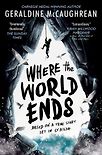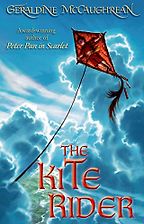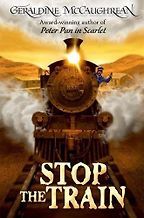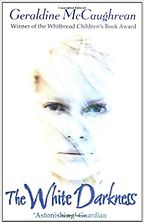Let’s start with the books you’ve written based on true stories – or in some cases just a scrap of history. What do you think inspired you to delve deeper into these particular events and to write books based on them?
I suppose every author tends to see a story in whatever it is they’re reading or watching or hearing about. The least little things can become the inspiration for a book or a story. With 99% of them, you think, “Oh that would make a good story” and then forget all about it. But now and then there’s something that catches in your brain and is a starting point for a story. Then the tendency is that the more you read about it the better it becomes. The truth is often a lot stranger than fiction.
Let’s start with your book, The Kite Rider, which is set in 13th-century China – the plot is complex and exciting but essentially begins with a young boy watching his father test the wind by flying on a man-carrying kite.
The Kite Rider was one of the books I began knowing only what my first page was going to be – nothing after that. By chance one day I saw a poster for an exhibition at the V&A showing man-carrying kites in Japan. I thought, “Wow, amazing.” But I was in the middle of doing six other jobs at the time. By the time I wanted to start, the exhibition was over, and I couldn’t find out anything, anywhere about man-carrying Japanese kites. All I kept finding and reading about was Marco Polo, the first Westerner to see kites – in Cathay.
Marco Polo witnessed a superstitious ritual performed before a ship set sail, in which a member of the crew was taken and lashed to a hatch cover and flown like a kite. (The man with the horse-shaped eyes at the beginning is supposed to be Marco Polo watching it.)
I thought, “There’s my first page. Now where? What else was happening in China at about this time?” Kublai Khan was happening. A foreign occupying power. So, then I thought, “All right, what do we know about Kublai?”
“For those days Kublai Khan was a very enlightened despot”
He was extraordinary. For those days Kublai Khan was a very enlightened despot. When he invaded didn’t just kill everybody but would take the cleverest ones and incorporate them into his government.
He had this quaint idea that, since it would dishonour a king to have his blood spilled on the ground, rather than cutting his head off, you should wrap him in a carpet before galloping your horses over him and killing him. It was a mark of respect. He also had a white tiger and lived in a yurt. Here was truth offering so much colourful material to fictionalise. He sort of wrote bits of the book for me old Kublai!
I could only assume the V&A’s Japanese man-carrying kites had been used as weapons of war. Anyway, despite it being set in Cathay, I moved that idea into Kite Rider. The hero ends up being used as an aerial weapon.
Let’s move on to a story that is set a little closer to home – but which in many ways is as alien a culture to many of us now as 13th century China. Where World Ends, is the story of a group of fowlers stranded on the remote Stac an Armin, which is off St Kilda in Scotland,in 1727.
There again, like the kites, Where the World Ends was based on something that I could really not research at all because there was so little written about it. That’s the appeal of coming across something like that. Everybody’s written about Marie Antoinette or Mary, Queen of Scots – it’s never appealed to me to go somewhere that everybody else has written about. But finding this tiny, couple of sentences about boys marooned on a sea stack – and nobody went to get them back – just started me thinking. Whatever did they suppose had happened? The possibilities could have been anything from the sublime to the unthinkable.
The very last woman who had lived on St. Kilda died about the time I was writing the book. So it was rather a strange experience really – writing about a community that no longer exists. Yet, there’s a huge public fascination in the place, which I didn’t realise until the book came out. The Scots in particular are just obsessed with the whole idea of St. Kilda.
I think it’s the remoteness of the place. The fantastically primitive life that those fowlers must have led when they were so isolated and relied so completely on the birds.
It sounds staggeringly beautiful, this remote island community, but I remember thinking while reading that I’m not sure how I’d manage. I’m used to living in much larger communities.
I was going to do a kind of Lord of the Flies, but with a positive twist, based on their religious ideals. The people of St Kilda, though very superstitious, were devout Christians. I thought, “Well, what if they set up this perfect utopian society?” But it didn’t work. It didn’t work because there wasn’t a villain. You need opposition. You can’t have light without dark and so the story turned out entirely differently. Always a good sign, I think, with a book. The book wrote itself.
Stop the Train is set during the Oklahoma land runs of the 1890s – what set you off across the Atlantic for this story?
Stop the Train was the result of watching TV! Shocking, really, that I should sit there thinking, “I could turn this documentary into a novel.” But I did. I thought, “Oh if only I’d pressed record.” This is a long time ago. There wasn’t any i-Player back then.
I took myself off to the BBC where for a tenner you could watch any programme again in the basement. I watched this documentary, made notes and turned it into a fiction. The town in the documentary was Enid in Oklahoma and dates back to the 1889 Land Run (when everybody could race into Oklahoma and grab a piece of land).
The people who raced there by train would get out at a putative station, which didn’t exist and wasn’t anything but a patch of prairie, and build a town round it, with the expectation that the town would grow and ranchers would bring their cattle in and put them on the train.
Sign up here for our newsletter featuring the best children’s
and young adult books, as recommended by authors, teachers, librarians and,
of course, kids.
So, when the rail owners decided that they weren’t going to stop at Enid the people of Enid went barmy and did everything they possibly could to persuade them otherwise. They shot at the trains and ripped the rails up. I thought, “Yay! I can definitely do something with this!”
They were amazing people. They got off the train with their only worldly goods, dug themselves a hole in the ground and put a tarpaulin over it and lived like prairie dogs. The first winter it was so cold that the milk froze in their goats and the women’s dresses froze to their legs.
The importance of this train stopping there, I mean otherwise they are just isolated and will die there. They need that connection, don’t they – for the town to have a future?
Isolation’s good, though, isn’t it, in a fiction? Because it isolates readers as well and they feel the need to get out at all costs. Panic keeps them reading! But yes, the town really had to stop that train.
The reading of this book has led me on to find out something about the history that just wasn’t on my radar before. In this age of the internet it is so easy to google and find out more about the real lives behind the story. It extends the pleasure of a good book! In fact, you did too as this story continues, doesn’t it, in Pull Out All the Stops!?
I think some of my favourite characters are in there, especially the schoolteacher. I got so fond of them that I wanted to bring them back. It’s the first time I’ve ever been tempted to write a sequel. This time it was paddle steamers rather than trains.
Sometimes characters just materialise. It’s one of the magics of writing: you can invent two people, put them in a dark place and wait for them to speak. And they come out with something you’re not expecting them to say!
How much research did you do?
I’d watched the documentary so I had quite a lot of the information. I read up on the land runs, obviously. Eventually, a year or so later I actually visited Enid, which is now a place that’s got a railway museum, for obvious reasons. I was really glad that I hadn’t gone there while I was writing the book, though, because the prairie, which I’d imagined as this huge, menacing open space, just looked like the English countryside. It was so mild and gentle with soft rolling grassy fields …and five lane highways.
What do you think of the expression ‘truth is stranger than fiction’?
Fiction is a more pleasant place to be sometimes, but not because it’s invented. A basis in truth certainly makes for more original content. Such extraordinary things have happened to people. Such extraordinary people exist.
The Ideal Wife is a book written for grown-up fiction shelves, but I think would work very well for the YA market as so many of your books do. It’s a much darker version of Pygmalion in many ways. Your main character wants to create the perfect wife and believes he can do so by adopting two girls and raising them to his philosophical ideals. And intending to marry the best one!
The Ideal Wife was based on something I read about in a colour supplement, not that I’m much given to reading colour supplements, but it was about someone very local to where I live. He was a great fan of Rousseau. He adopted two girls with a view to keeping them and marrying whichever one turned out best – and marrying off the one that didn’t turn out so well. Which is a really creepy idea. He raised them on Rousseauian ideals.
It’s a monstrous idea to adopt two orphaned children and raise them up to find out which one you fancy most – which one fits best to your ideals.
It’s worth pointing out that there is nothing particularly sexual in his motives – it’s more his commitment to his philosophy.
He’s so wrapped up in himself that he doesn’t really notice the sexual aspect. His intentions are almost scholarly – scientific – but he’s cruel. He’s inadvertently absolutely wicked. He was eventually (in real life, I mean) killed by his horse. His horse kicked him in the head, which I would have liked to use in the book, but it didn’t lend itself.
Speaking of dark stories with a twist of cruelty let’s talk about your final choice, The White Darkness. This is the story of a young girl who is essentially tricked by her uncle into embarking on a dangerous and foolhardy journey with him to Antarctica. The uncle believes in the “Hollow Earth Theory” and hopes to prove it with this expedition. Within this setting you also create an imaginary platonic relationship between the main character, Sym, and the late Titus Oates, one of the doomed members of the Scott Expedition. It’s a fascinating read, quite unexpected. Can you tell me about the inspiration for this book?
I had no idea when I wrote this whether it would work at all because it was the only book really that I’ve ever written about myself. My personal experience of life, I mean. It was what teenage life was like for me. But I didn’t write it until my own daughter was of that kind of age and clearly experiencing teenage years in exactly the same way I did. She didn’t want to join in the dirty talk. She didn’t really see the point of boys.
The imagination was, for me, a so much better safer and brighter place to spend time than competing with the loud girls at school. So that was my theme: the interior world. The White Darkness is most appreciated, in my experience, by 14 year old girls who are still at a stage when they have a lively interior world, but their mates are hell-bent on adulthood.
I’d been toying with an idea of them walking across the frozen Bering Strait but it wasn’t working. Then I translated it to Antarctica and thought about Scott’s expedition.
All of a sudden, I came up with this interior world that the girl had. Sym is in love with Titus Oates, so she takes all her problems to him and talks to him inside her head. He is, of course, lovely and consoling in every way, (though I think that, in real life, he was a rather anti-social, grumpy man who did his shoes up with wire.)
And on top of this you’ve got this thread of the “Hollow Earth Theory”, which did exist, but is in fact a conspiracy theory. It’s a true story that’s not true!
The “Hollow Earth Theory” was probably a money-making scam originally. Several eminent US statesmen were convinced at the time. It claimed there were holes in the earth’s crust at each pole which let in the sunlight and would allow the hollow insides to be explored. There are still people left around that believe in it.
My idea for Titus Oates came from a wonderful book called, I May Be Some Time by Francis Spufford. It’s all about the British obsession with The Ice – i.e. Antarctica. It contains the most perfect retelling of the Scott expedition that made my heart pound because it was so beautifully written. I love that man’s writing.
I read up on Antarctica so much that I knew more than I’ve ever known in preparation for writing any book. It really got to me – the way it does to most people – but I still had no idea if my book would work. It was so ambitious and peculiar and mined from so deep inside me.
After it won the Printz Award in America, I started to get messages from people in Idaho and Nebraska who said, “I didn’t realise anybody else thought like me. This is just how I feel.” It was amazing to think that teenage life really hasn’t changed very much over the years.
Finally, a list of books based on true stories by other children’s authors that you’d like to recommend:
Song Hunter by Sally Prue is based on an unrecorded historical event but one that must logically have happened: the moment when Neanderthal man collided with Homo Sapiens: when things other than basic survival and reproduction were coming into being – like art and music. What an impossible barrier there must have been between brains geared to basic survival and brains yearning after spirituality and creativity. Young people are the ones who ‘bridge the gap’ in the book, of course.
Tall Story by Candy Gourlay was sparked by a newspaper story Candy read in which the victim of an earthquake was able to…. oh. But no, that’s no good. I can’t give away the crux of the book. It’s full of unusual themes – basketball, gigantism, Filipino life – friendship and dilemmas – and it’s thoroughly life-affirming.
Life: An Exploded Diagram by Mal Peet, which culminates with the Twin Towers. It goes from bomb to bomb. Unexploded bombs to the Twin Towers via a wealth of wonderful characters and every kind of emotion. Apologies, though, for the spoiler.
The Prince Who Walked with Lions by Elizabeth Laird is about an Abyssinian prince who was brought back to England after his father had been killed by an English expedition to Abyssinia. He’s brought here and put in a boarding school. He’s confronted with the British upper-class system and copes as best he can. But he’s somehow like some noble lion taken out of its rightful habitat. Original and sad in that way only true-life stories can be.
Heartsong by Kevin Crossley-Holland, who’s always such good value, and with Jane Ray doing the illustrations, it’s also a really pretty book, too. Inspired by Vivaldi’s Four Seasons and the fact that Vivaldi used orphanages for practise runs of his latest pieces! The life-enhancing power of music and kindness, in four movements, that’s what.
Interview by Zoe Greaves
June 10, 2018. Updated: September 19, 2025
Five Books aims to keep its book recommendations and interviews up to date. If you are the interviewee and would like to update your choice of books (or even just what you say about them) please email us at [email protected]
Five Books interviews are expensive to produce. If you've enjoyed this interview, please support us by donating a small amount.












